LAB REPORT
Science and Technology Making Headlines
June 7, 2019

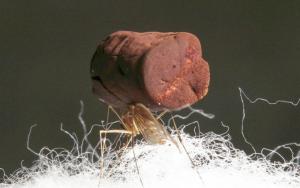
A mosquito standing on cotton fibers carries a sample of ultra-low-density gold aerogel. Photos by Joshua DeOtte.
Heavy metal gets light
Gold, silver and copper are heavy metals, but LLNL scientists can now make them nearly as light as air — in a form so tiny it can ride on a mosquito's back.
The groundbreaking science, part of a joint National Ignition Facility/Physical and Life Sciences (NIF/PLS) project supported by the Laboratory Directed Research and Development Program, created these ultra-low density metal foams to give physicists better X-ray sources to employ in experiments that support NIF's Stockpile Stewardship mission.
The foam is the product of a nearly decade-long research effort by members of the Lab's NIF and PLS directorates for use on inertial confinement fusion experiments at NIF, the world's most energetic laser system.

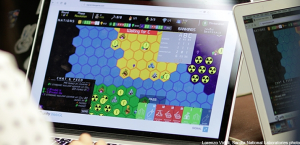
LLNL and Sandia researchers have developed a multiplayer war game to collect decision-making data.
A signal to make decisions in war
Military strategists have long relied on war games to gain insight into how human decision-making might impact a tense confrontation or actual conflict. The current generation of war games -- in which a small number of military and political officials conduct table-top exercises -- are so limited in scope that analysts don’t get much more information than they might from watching a game of Risk.
Because there are so few players, there is not enough data to draw statistical inference.
Signal, however, is a new cloud-based, multiplayer game designed to collect decision-making data from a much broader set of players. It runs on Amazon’s cloud platform and employs state-of-the-art game engines to deliver a more realistic experience for participants. It was funded by the Carnegie Corporation and developed by researchers from the Lawrence Livermore and Sandia national laboratories along with a team from Berkeley that included members from the departments of electrical engineering and computer sciences, nuclear engineering, political science and the Goldman School of Public Policy.
"Traditional discussion-based exercises have led to a theory-rich, but data-poor environment, said Andrew Reddie, an LLNL team member and Ph.D. candidate in Berkeley's political science department. "Using new tools, we're arguing that board games and electronic games can complement traditional war gaming by providing a science-based, experimental framework for gathering data."

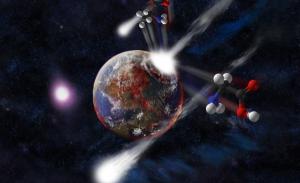
This simulation depicts a comet hitting the young Earth, generating the amino acids necessary for life. Image courtesy of Matthew Genge/Imperial College London.
It’s smashing: Comets jumpstart life on Earth
Researchers have known for years that amino acids caught a ride on comets and meteorites that bombarded early Earth.
But they never really knew if those building blocks of life survived upon impact. New Lawrence Livermore research using quantum simulations shows that comets and other celestial bodies may have not only delivered building blocks for life to Earth, but also synthesized them on impact
The LLNL team discovered that exposing glycine solutions to sudden heat and pressure – 4,000 degrees Fahrenheit and 480,000 atmospheres of pressure to mimic a comet impacting Earth – can yield carbon-rich structures, including prebiotically important nitrogen-containing polycyclic aromatic hydrocarbons (NPAHs).

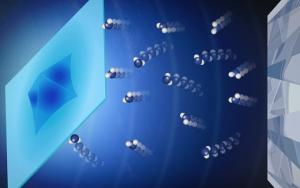
This schematic illustration depicts the transition of ice growth by dynamic compression using the advanced dynamic diamond anvil cell, which enhances interface structure and leads fast kinetics of water-ice interface, initiating two-dimensional shock growth even near equilibrium melting pressure. Illustration by Yong-Jae Kim and James Wickboldt/LLNL.
New research is crystal clear
Crystal growth is a crucial issue for fundamental science and wide applications. The growth morphology and speed are generally determined by an interplay between macroscopic thermodynamic driving forces and the microscopic kinetic process at crystal-liquid interface.
While crystal growth is well understood at near-equilibrium growth conditions, the growth transition with diverse growth morphologies is poorly understood under nonequilibrium growth conditions (e.g. dynamic compression).
A study recently published in the Proceedings of the National Academy of Sciences provides a new insight of crystal growth under dynamic compression using an advanced dynamic diamond anvil cell technique, which bridges the unknown behaviors of crystal growth between static and dynamic pressure conditions. The work was conducted by a collaborative research team from the Korea Research Institute of Standards and Science (KRISS), University of Science and Technology (UST) in South Korea and Japan's National Institute of Advanced Industrial Science and Technology (AIST). Co-lead author Yong-Jae Kim, a physicist at Lawrence Livermore National Laboratory, conducted the research as a postdoctoral researcher at KRISS.
"Our study makes a step forward in better understanding and predicting crystal growth in the real world, from diverse snowflakes to planet interiors at extreme conditions," Kim said.

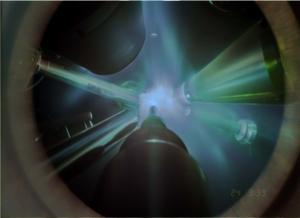
In this time-integrated photograph of an X-ray diffraction experiment, giant lasers focus on the water sample, sitting on the front plate of the diagnostic used to record diffraction patterns, to compress it into the superionic phase. Credit: Millot, Coppari, Kowaluk/LLNL.
It’s black, hot and icy
A new state of ice that is black and hot at the same time forms the most giant icy worlds in the Milky Way.
Lawrence Livermore scientists and collaborators have confirmed the existence of “superionic ice,” a new phase of water that is black and hot first theoretically predicted more than 30 years ago. Although it has never been seen until now, scientists think the new state of matter, it might be among the most common forms of water in the universe. “
The discovery of superionic ice at the Laboratory for Laser Energetics at the University of Rochester, potentially solves the puzzle of what giant icy planets like Uranus and Neptune are made of. They’re now thought to have gaseous, mixed-chemical outer shells, a liquid layer of ionized water below that, a solid layer of superionic ice comprising the bulk of their interiors, and rocky centers.
Across the solar system, more water probably exists as superionic ice — filling the interiors of Uranus and Neptune — than in any other phase, including the liquid form sloshing in oceans on Earth, Europa and Enceladus. The discovery of superionic ice potentially solves decades-old puzzles about the composition of these “ice giant” worlds.





